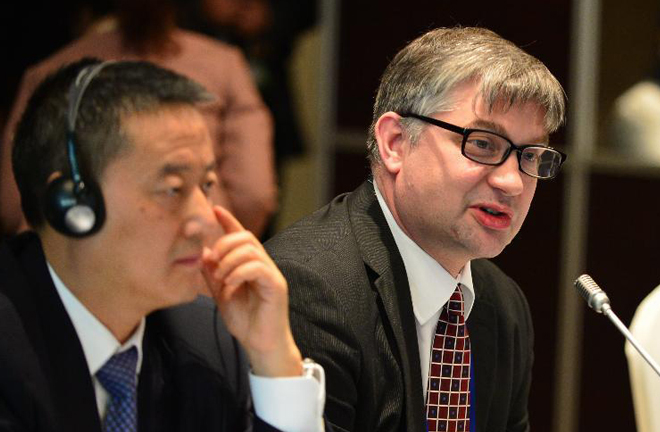European perspectives about One Belt, One Road

Attendees at the international seminar on the 21st Century Maritime Silk Road initiative held in Quanzhou in Fujian Province
The Institute of European Studies under the Chinese Academy of Social Sciences (CASS) held a symposium on the One Belt, One Road initiative on Feb. 10 in Beijing. Scholars discussed responses to the initiative from European academic circles.
The Silk Road Economic Belt and 21st Century Maritime Silk Road aim to enhance communication with neighboring countries through deeper economic cooperation and people-to-people exchanges.
The One Belt, One Road initiative connects Central Asia, South Asia, Southeast Asia, West Asia and other sub-regions. It aims to benefit Central, Eastern and Western Europe.
The One Belt, One Road initiative has drawn a lot of attention from the international community since it was launched in 2013. Scholars and experts from foreign think tanks have interpreted it from different angles. Some foreign scholars held that the initiative is complementary to the concept of the “Chinese Dream,” adding that it is conducive to tackling problems in China as it strives for peaceful, common development.
Central and Eastern Europe response
Central and Eastern Europe are key regions within the One Belt, One Road framework. Many high-level think tanks in these regions have included One Belt, One Road into their research topics. By means of survey and statistical analysis, Liu Zuokui, an associate research fellow from the Institute of European Studies at CASS, said there were five categories of responses among think tanks in Central and Eastern Europe to the One Belt, One Road initiative: misunderstanding, facts-only interpretation, wait-and-see, policy acknowledgment, and diversified views.
Think tanks in the first category have no idea what the initiative is about and only judge it based on previous knowledge and perception. Think tanks in the second category only know basic facts of the initiative without an in-depth understanding of it. Think tanks in the third category lack sufficient understanding about the initiative and have not responded. Think tanks in the fourth category are mainly from the Balkans, especially West Balkans, where there is greater influence from the initiative. Think tanks in the fifth category have a diversified understanding of One Belt, One Road.
The survey found that scholars from think tanks in Central and Eastern Europe regard One Belt, One Road both as a “geopolitical and geo-economic initiative.” Many scholars look forward to a future with increased people-to-people exchanges, but are unclear about the prospects surrounding infrastructure, financial cooperation and other fields.
Western Europe response
The survey found that think tanks in Western Europe responded more rationally to One Belt, One Road compared with those of Central and Eastern Europe.
Some Western European scholars deemed that Central Europe may cooperate through the initiative of One Belt, One Road under the premise of not going against the existing framework of the UN.
Xiong Wei, deputy director from the Department of Diplomacy and Foreign Affairs Management at China Foreign Affairs University, noted that some German scholars are positive about the economic benefits of One Belt, One Road. However, due to the lack of coping mechanisms and long-term planning for security threats, such as extremist groups and terrorist forces, it is uncertain whether China will succeed in expanding westwards existing strategies for maintaining regional stability through the initiative. Additionally, further implementation of interconnection will also result in China facing more threats from terrorist forces.
Quite a few think-tank scholars applauded One Belt, One Road, hailing it as a development opportunity. In recent years, China has vigorously promoted financial cooperation under the framework of One Belt, One Road. Some Greek scholars are not so optimistic about concrete measures, such as the Asian Infrastructure Investment Bank and the Silk Road Fund, citing concerns about the operation mechanisms of these new institutions.
Furthermore, some Western European scholars view One Belt, One Road as a measure for “game and competition between great powers.” Some think it beneficial to combating Trans-Pacific Partnership and Transatlantic Trade and Investment Partnership of the US; others insist it conflicts with Russia’s development planning in the long run or poses a challenge to China-Russia relations.
Implementation of One Belt, One Road has opened a new window for European studies. Scholars at the CASS symposium agreed that Europe is an important region within the framework of One Belt, One Road. They also noted it is of great significance to intensify studies of relevant aspects in Europe for China to push forward the strategic decision of One Belt, One Road.
